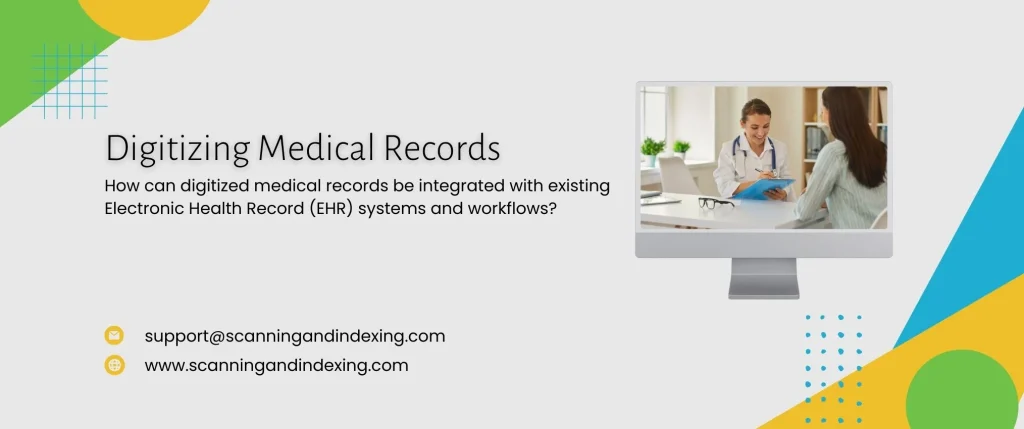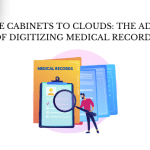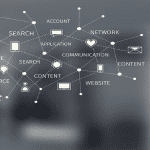How Can Digitized Medical Records Be Integrated with Existing Electronic Health Record Systems and Workflows?
Streamlining healthcare processes is made possible by including digitized medical records in Electronic Health Record(EHR) systems. It helps improve care for patients and cut down on wasteful operations. However, this integration needs a clear plan to ensure it fits in with current processes without any problems. Healthcare workers can ensure that digital records work well with EHR systems without stopping normal operations by using advanced tools, following standard practices, and putting interoperability first.

Ensuring Compatibility of Digitized Medical Records with EHR Standards
The accessibility of data and the risk of mistakes connected with paper records are improved by digitized medical records in EHR systems. To integrate, healthcare workers must ensure that digital data forms are compatible with EHR standards. This process includes turning paper medical information into structured digital formats that EHR platforms can easily search and recover. Also, healthcare organizations should pay for staff training to help doctors and nurses get used to new ways of doing things.
Leveraging Medical Record Digitization Services
You need a trusted medical record digitization service for electronic records to work with EHR systems. These services are experts at scanning, sorting, and processing paper records while ensuring they align with HL7 and FHIR standards for healthcare data. With these services, healthcare groups can ensure that digital records work with their current EHR systems, reducing the number of problems when they try to connect the two. These services also usually come with tools to ensure quality. These keep the correctness and security of digital records.
The Role of Electronic Health Record Systems in Integration
The Electronic Health Record (EHR) method is essential to managing healthcare data today. For digital medical records to work well together, EHR platforms need to be able to work with a range of data types and tools. To do this, healthcare companies must work with their EHR providers to set up custom workflows that include digital records. Natural language processing (NLP) and other advanced features can also help to turn unorganized data into insights for usage in the EHR system.
Streamlining Data Management with Advanced EHR Systems
Healthcare workers can use cutting-edge EHR systems to handle data quickly and easily, speeding up the integration process. By using skilled pros and automated tools, digital information can be easily moved into EHR systems. The service providers check that the data entry is correct, which lowers the risk of mistakes that could hurt patient care. Healthcare organizations can focus on their primary medical services while outsourcing this job, ensuring that the shift of digital data into EHR processes goes smoothly.
Addressing Data Security and Compliance Challenges
Improving EHR integration also means dealing with data security and safety issues. To protect private health data, digitized records must follow strict healthcare privacy standards like HIPAA. To do this, healthcare groups must use strong encryption, safe storage options, and frequent checks. Adding these steps to current EHR processes will keep patient data safe during and after the digital process.
The Benefits of Partnering with Medical Record Digitization Services
By working with a reliable medical record digitization service, healthcare workers can ensure the integration goes smoothly without stopping what they’re doing. Not only do these services scan information, but they also help with the moving process. They ensure that all the data is correctly organized and labeled to be used with EHRs. They also offer ongoing help to deal with any technical problems that may come up. They ensure that an up-to-date and effective EHR system has been running well for a long time.
Enhancing Adaptability of Electronic Health Record Systems
Another essential part of the merging process is the flexibility of electronic health record systems. It is possible to enter a lot of different types of data into modern EHR systems. Adjustable APIs and third-party interfaces, including digital records, are used. By using these features, healthcare groups can ensure that digital records work well with their existing processes. Also, keeping EHR software up to date can help fix compatibility problems and add new features that make handling large amounts of data easier.
Achieving Efficiency by Integrating Digitized Data and EHR Systems
The fastest and most accurate way to send digital medical records is to integrate EHR systems. The expert service providers use digital tools and skilled workers to speed up the process and reduce mistakes and delays. This is especially important in big healthcare companies with many digital records. These businesses can maintain their high output levels during the change phase thanks to efficient data entry services.
Conclusion
EHR integration into digital medical records is a complex process that requires people to work together, develop new technologies, and follow data standards. Healthcare companies can make the change go smoothly by using specialized digital services. This integration improves the speed of operations, improves patient care, and ensures that healthcare groups are ready for the future of digital healthcare management.
If you want to partner with us, send your requirements to [email protected].





